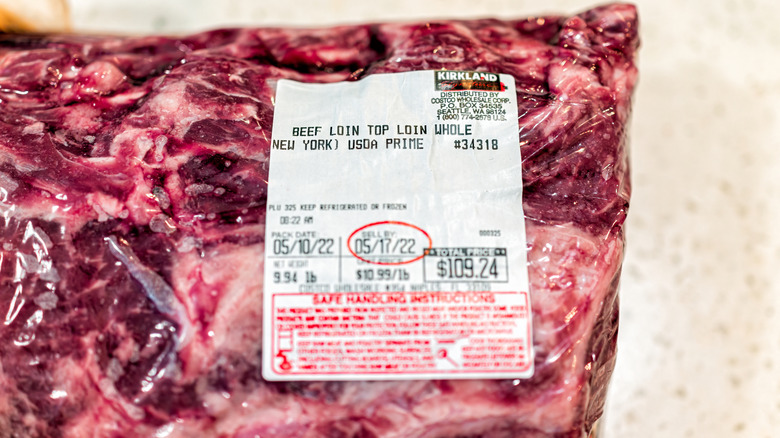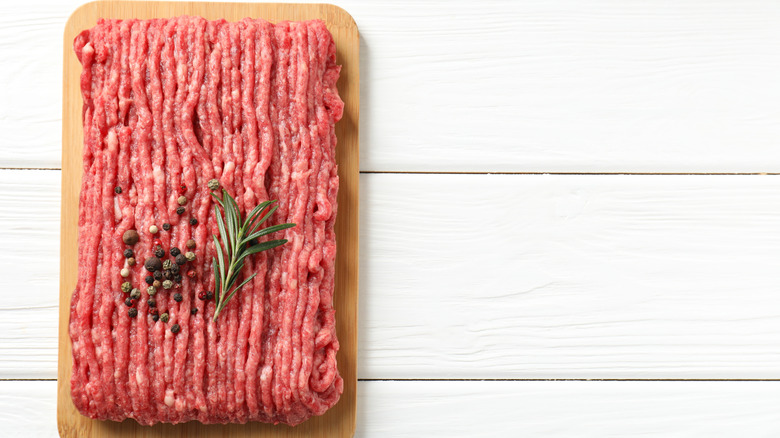7 Facts About Costco's Meat Department You'll Wish You Knew Sooner
Costco's meat department might seem straightforward at first glance — just rows of bulk-packaged beef, pork, and chicken — but regular shoppers know there's more going on behind the scenes. Whether you're feeding a big family or just looking to stock your freezer, the warehouse giant offers serious value if you know what to look for. While most people come for the savings, those in the know come for the secrets.
From rotisserie chickens priced so low they're practically a marketing strategy to premium-quality steaks that require a little extra cooking know-how, Costco's meat section is packed with quirks that can help you shop smarter and save more. Some of these insider tips are buried in small print, hidden behind the butcher counter, or simply passed around by word of mouth among seasoned members. And unless you've been asking the right questions — or cutting your own strip loins in the kitchen — chances are you've missed a few.
We've rounded up the most surprising, helpful, and genuinely little-known facts about Costco's meat department. Whether you're a first-timer or a die-hard Kirkland loyalist, these are the secrets you'll wish you knew sooner.
Costco's $4.99 rotisserie chickens are strategically priced
Costco's rotisserie chicken isn't just a convenient dinner option — it's a carefully calculated part of the retailer's overall strategy. At just $4.99, the ready-to-eat bird hasn't gone up in price in over two decades. That's not because it's cheap to produce. In fact, Costco loses money on every chicken it sells.
The real value of the rotisserie chicken comes from what it represents. Priced well below market rates, it signals to shoppers that Costco offers unbeatable deals. It's a psychological anchor that helps build trust with customers — if the chicken is a bargain, everything else must be too. That feeling encourages shoppers to spend more time browsing and buying once they're inside.
And speaking of browsing, Costco intentionally places its rotisserie chickens at the back of the store. To grab one, customers have to pass through aisles filled with everything from electronics to wine — high-margin products that more than make up for the loss on poultry. This tactic is designed to maximize impulse purchases and increase the average basket size. What looks like a generous deal is actually one of Costco's most effective tools for driving profit. The rotisserie chicken might not bring in revenue directly, but it's working hard behind the scenes.
Costco owns its own chicken supply
Costco doesn't just sell rotisserie chickens — it controls the entire process behind them. In a bold move to manage rising costs and meet its quality standards, the company built its own poultry complex in Fremont, Nebraska. This facility, which includes hatcheries, grower barns, feed mills, and a processing plant and contracts with area farmers to help raise chickens, is responsible for producing a large percentage of the rotisserie chickens that line the back of its Costco warehouses.
Before this shift, Costco relied solely on third-party suppliers, which limited its ability to control pricing and quality. As demand increased and poultry prices rose, the $4.99 price tag on its signature chicken became harder to maintain. Rather than raise prices, Costco decided to bring production in-house — an unusual and ambitious move for a retailer.
By having a role in the supply chain, Costco can ensure consistent sizing, freshness, and ethical sourcing while reducing reliance on outside vendors. It's a vertically integrated system that not only preserves the affordability of one of its most iconic products but also gives Costco more flexibility in how it operates its meat department overall. This chicken facility is just one part of a broader strategy: invest upfront to control costs and deliver value. In the case of poultry, Costco is literally raising the bar — and the birds — itself.
Costco mechanically tenderizes its steaks
Ever wonder why Costco steaks always seem extra juicy and tender? It turns out there's a secret process at work — one that you might not even notice unless you're paying close attention to the label. Most pre-cut steaks at Costco are mechanically tenderized using a process called blade tenderization.
This technique involves running the meat through a machine that uses tiny blades to pierce the muscle fibers. The result? Steaks that are noticeably easier to chew, with a texture that feels more like what you'd expect from a high-end steakhouse. For shoppers, it's a subtle upgrade that makes a big difference in taste and tenderness, especially when cooking at home.
While this isn't unique to Costco, it is something the warehouse chain does consistently — and more transparently than many competitors. You'll often see "blade tenderized" printed directly on the packaging. It's a detail many customers overlook, but it helps explain why Costco's beef gets rave reviews despite its warehouse price tag. It's worth noting that whole cuts like full ribeyes or strip loins are not tenderized. It's mostly the individually cut steaks and roasts that go through this process. So if tenderness is a priority, those pre-cut packages may be your best bet.
Kirkland Signature meats are often sourced from premium brands
While Costco's Kirkland Signature label might suggest a generic store-brand product, that's far from the truth — especially in the meat department. In many cases, Kirkland items are produced by well-known national brands, giving customers top-tier quality at a lower price point. Take the bacon, for example. While it carries the Kirkland name, it's believed to be produced by Smithfield, one of the largest and most trusted pork processors in the United States. The product specs and flavor profile are nearly identical to the name-brand version, but it's sold at a warehouse price under Costco's private label.
This isn't just a one-off case. Costco has a long history of partnering with big-name producers to manufacture its Kirkland Signature meats. These partnerships allow Costco to ensure consistent quality and supply while cutting out some of the marketing and distribution costs that typically raise retail prices. It's a win-win: Suppliers move large volumes through a trusted retailer, and Costco members get high-quality meat without the brand-name markup.
So the next time you pick up a pack of Kirkland steaks, ribs, or bacon, know that it likely shares a supply chain with brands you already trust — you're just not paying extra for the label.
You can save money by purchasing larger cuts and portioning them at home
If you're looking to stretch your grocery budget without sacrificing meat quality, Costco's meat department has a solid hack: buy in bulk and cut it yourself. Rather than going straight for the pre-sliced steaks, savvy shoppers head for the whole roasts and primal cuts. With a little effort and a sharp knife, you can turn a rib roast into ribeye steaks or a strip loin into New York strip steaks — and save a few dollars per pound in the process.
The initial price tag might be intimidating since these cuts are sold in larger portions, but the cost per pound is often significantly lower than buying individually packaged steaks. One shopper documented a nearly $2.50-per-pound difference between a whole strip loin and the pre-cut steak version — and that's not a rare find.
With a little planning and DIY spirit, Costco's bulk meat section can rival your local butcher in both price and flexibility.
Costco's meat prices have a lower markup compared to other retailers
One of the biggest ways Costco maintains its reputation for value is by limiting product markups — and that includes meat. Unlike traditional grocery stores that often mark up items by 25% to 50%, Costco caps its markup at around 15%. This company-wide pricing policy applies to everything from electronics to essentials — and yes, to those big trays of steaks, roasts, and ribs in the meat department.
Because the chain earns fees for its memberships, which are good at any Costco location worldwide, it doesn't need to rely on high product margins to stay profitable. That's a huge advantage for customers, especially when it comes to expensive items like meat. Whether you're shopping for a whole brisket, a pack of pork chops, or USDA Prime steaks, you're more likely to find competitive pricing at Costco than at a standard supermarket.
This low-margin model also allows for quicker inventory turnover, helping ensure that meat and other perishable items stay fresh. It's a system built on efficiency, volume, and customer trust — and the meat department benefits directly from that approach. So while other retailers sneak extra costs into their meat pricing, Costco keeps things lean — literally and financially.
You can purchase leaner cuts of ground beef by requesting a 'chub'
Most shoppers pick up ground beef straight from Costco's display case, assuming what's available is their only option. But seasoned Costco members know there's a hidden alternative — the 10-pound "chub." This unassuming tube of ground beef is kept behind the scenes and typically isn't stocked in the meat case, but you can request it from a meat department employee.
The difference? These chubs usually contain leaner beef, often in the 92%-95% range, compared to the more common 88% lean blends found in pre-packed trays. They're also sold at a lower price per pound. Because the chub packaging skips the foam tray and shrink wrap, it cuts down on packaging costs — savings that are passed on to the shopper.
This makes chubs an excellent option for meal preppers, families, or anyone looking to stock their freezer with a healthier ground beef alternative. You'll need to portion and repackage the meat at home, but the cost savings and leaner content are well worth the extra effort. It's not advertised, and most casual shoppers don't even know it exists — but for those in the know, it's one of the best meat department hacks at Costco. The next time you're shopping, try asking for a chub at the counter. You might be surprised by how much you save.







